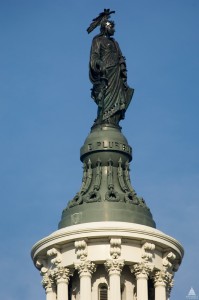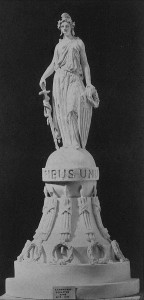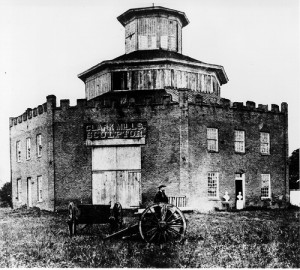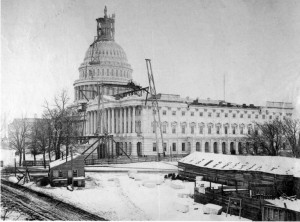The Focus of a Nation
Posted By Jake Wynn on January 21, 2013
Being Inauguration Day, it seems relevant to explore a topic relating to the nation’s capital. The statue adorning the top of the Capitol Dome fits that bill. While most of us have probably not taken special notice to the 15,000 pound bronze statue sitting atop the nation’s most recognizable landmark, it attracted much attention during the dome’s construction in the 1860s.
Freedom, or as she was originally known as, Freedom Triumphant in War and Peace, was designed by American sculptor Thomas Crawford. He was chosen to design the sculpture in 1855 by Captain Montgomery Meigs, later to become famous for creating Arlington National Cemetery, who was overseeing construction of the Capitol Dome for Secretary of War Jefferson Davis. One of the models originally created by Crawford was deemed by Davis to be inappropriate, because upon its head sat a “cap of liberty.” This headgear, Davis believed, would be construed as a symbol of emancipation, and was changed to a helmet adorned with bronze feathers.
Thomas Crawford would never see his finished Freedom. He died suddenly in 1857, just before the final plaster model was to be shipped for casting. Of the statue, Crawford said:
I have endeavored to represent Freedom triumphant – in Peace and War…In her left hand she holds the olive branch while the right hand rests on a sword which sustains the Shield of the United States. These emblems are such as the mass of our people will easily understand…. I have introduced a base surrounded by wreaths indicative of the rewards Freedom is ready to bestow.
Ironically, the Statue of Freedom was completed with the assistance of a Maryland slave. The contract for the bronze casting belonged to Clark Mills of Washington D.C. His foundry, which lay on the border between the District of Columbia and Bladensburg, Maryland would be responsible for casting the 19’ 6” statue.
The slave, Philip Reid, did most of the work, endeavoring through much of 1860 and 1861 separating and casting the different sections in bronze. Reid would be one of the last enslaved people to ever work on the United States Capitol, and while he worked on the statue, he became a free man, when President Abraham Lincoln abolished slavery in the District of Columbia.
The statue was completed in 1862 and would have to wait for the new Capitol Dome to be structurally sound in order to handle Freedom’s seven and a half ton payload. Once the dome was deemed sufficient, Freedom was hoisted above the Capitol. A 35 gun salute paid tribute as the statue was completed atop the Capitol Dome on December 2, 1863, standing over Washington D.C at a height of nearly 300 feet.
Reaction surrounding the installation of Freedom was mostly positive. Or was it?
Here is an interesting editorial piece about the statue published by the Philadelphia Inquirer on December 21, 1863, just a few weeks after the statue’s ascendency to the top of the dome.
The Statue on the Dome of the Capitol.
To the Editor of the Age – Public attention has recently been drawn to the so—called colossal statue of Liberty, which has just been placed over the Capitol dome at Washington, after having been coated with a weather-proof chemical preparation which gives it a mulatto color. When the writer visited Mr. Crawford’s studio some years ago in Rome, he saw the model, and understood that it was that of the statue of America. The lamented artist himself was then moribund, but the Italian assistants in charge of the studio, conversed freely upon the different works there.
The Internal evidence presented by an examination of the statue itself, or even of the engraving of it on the five dollar greenbacks, shows it to be that of America and not that of Liberty. The shield is emblazoned with the arms of the United States, the head is adorned with a diadem of stars, and the helmet with an eagle’s head and plumes, and the broach marked with the cipher U.S. The pedestal in the cut on the greenbacks is marked with the inscription “E Pluribus Unum” which is probably, however, an adoption by some other hand than Mr. Crawford’s. The Phrygian cap and other well known emblems would be appropriate to a statue of Liberty, and not the helmet, spear and shield. If these consideration should be insufficient to decide the question (which should certainly be done in justice to the artist and his work), then Mr. G. S. Hillard, of Boston, the friend of Crawford, and the author of “Six Months in Italy” is probably most able to set the matter at rest.
For the information of the New York World, which objects to the mulatto color given by the weather proof coating, it may be stated that the exposure of the statue in the Capitol grounds previous to putting it into position, plainly verdeloped verdigris on the bronze surface, and showed, doubtless much to the disgust of the Republican officials, that the head of the presiding genius of the Capitol, like that of many others equally loyal, was a Copperhead.
The seemingly negative post ends with a clever play on the term Copperhead. The term had been coined by Republicans and hurled as an insult at Peace Democrats who railed for peace at the expense of the Union war effort. The statue undoubtedly provided an outburst of partisan politics.
What do you think about the statue?
Have you taken notice to it before?
We must use moments like these to take a deeper look at places and people we come across every day, because it might just yield some surprising stories.
Photos for this post come from the Library of Congress, the Architect of the Capitol and the National Archives.
 ;
;







How true your last statement is about taking a deeper look. I was at the VA hospital in Columbia, MO and took the time to read a posting on how the MU tigers got there name a few months ago. During the civil war, it was learned that the gurellia Anderson was going to attack the court house in Columbia. The home guard, the Missouri tigers gather to defend Columbia. Anderson never attacked, due to reputation of the tigers so it was believed. The first football team took the name of those tigers, which was then offiially adopted by the football team when it became a part of the university, which then became the mascot for the whole university. Interesting stories lie about us everywhere if we take the time to look.
Mmmmhhmmm… Partisan politics.